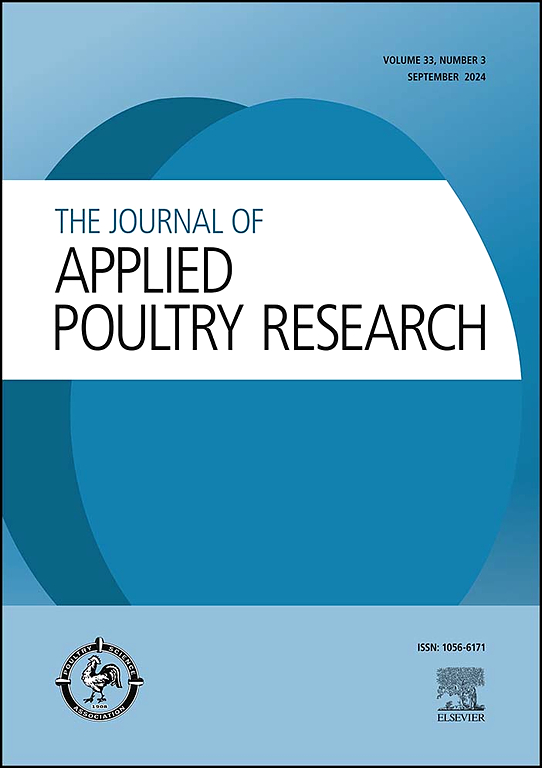Investigating the effect of 1,25 dihydroxycholecalciferol-glycosides and phytogenic antioxidants against bacterial chondronecrosis induced by aerosol transmission model
IF 2
3区 农林科学
Q2 AGRICULTURE, DAIRY & ANIMAL SCIENCE
引用次数: 0
Abstract
Bacterial chondronecrosis with osteomyelitis (BCO) lameness has been a major concern in the broiler industry, causing financial losses and animal welfare issues. BCO lameness is caused by a bacterial infection in leg bones. Pathogens enter the bloodstream via respiratory and intestinal epithelial translocation and infect the tibia and femoral heads of the birds. Supplementation of 1,25(OH)2D3 is crucial in regulating calcium and phosphorus homeostasis, immune system, and bone metabolism. 1,25(OH)2D3 glycosides derived from Solanum glaucophyllum (G-1,25(OH)2D3) were hypothesized to mitigate BCO lameness in broilers. In this study, G-1,25(OH)2D3 alone or in combination with phytogenic antioxidants were tested for their impacts on cumulative BCO lameness in the broiler population. BCO seeder group and the negative control had developed 78,0% and 73.5% cumulative lameness (P = 0.64), respectively. Supplementation of 1 µg/kg of G-1,25(OH)2D3 was more effective in reducing the cumulative lameness than 10 µg/kg of G-1,25(OH)2D3 (P < 0.05). There were no significant differences between 1 µg/kg of G-1,25(OH)2D3 alone or in combination with 500 mg/kg of a mixture of Curcuma longa plus Trachyspermum ammi (PH1), 750 mg/kg of a mixture of Solanum xanthacarpum plus Piper longum (PH2), or 500 mg/kg thyme oil. Therefore, 1 µg/kg of G-1,25(OH)2D3 provided better protection against BCO lameness compared to 10 µg/kg of G-1,25(OH)2D3. Additionally, the combination with phytogenic antioxidants did not result in any further reduction of cumulative BCO lameness compared to the use of G-1,25(OH)2D3 alone.
研究1,25二羟基胆钙化醇糖苷和植物性抗氧化剂对气溶胶传播模型所致细菌性软骨坏死的影响
细菌性软骨坏死伴骨髓炎(BCO)跛行一直是肉鸡行业关注的主要问题,造成经济损失和动物福利问题。BCO跛行是由腿骨细菌感染引起的。病原体通过呼吸道和肠上皮易位进入血液,感染禽类的胫骨和股骨头。补充1,25(OH)2D3对调节钙和磷稳态、免疫系统和骨代谢至关重要。从青花龙骨中提取的1,25(OH)2D3苷(g -1,25(OH)2D3)可减轻肉仔鸡BCO跛行。本研究测试了g -1,25(OH)2D3单独或与植物性抗氧化剂联合使用对肉鸡群体累积BCO跛的影响。BCO播种组和阴性对照组的累计跛行率分别为78%、0%和73.5% (P = 0.64)。添加1µg/kg g -1,25(OH)2D3比添加10µg/kg g -1,25(OH)2D3更有效地减少累积跛行(P <;0.05)。单独使用1µg/kg g -1,25(OH)2D3或与500 mg/kg姜黄加薄荷(PH1)混合物、750 mg/kg黄葵加长叶椒(PH2)混合物或500 mg/kg百里香油联合使用均无显著差异。因此,与10µg/kg g -1,25(OH)2D3相比,1µg/kg g -1,25(OH)2D3对BCO跛行有更好的保护作用。此外,与单独使用g -1,25(OH)2D3相比,与植物性抗氧化剂联合使用并没有导致累积BCO跛足的进一步减少。
本文章由计算机程序翻译,如有差异,请以英文原文为准。
求助全文
约1分钟内获得全文
求助全文
来源期刊

Journal of Applied Poultry Research
农林科学-奶制品与动物科学
CiteScore
4.10
自引率
10.50%
发文量
80
审稿时长
104 days
期刊介绍:
The Journal of Applied Poultry Research (JAPR) publishes original research reports, field reports, and reviews on breeding, hatching, health and disease, layer management, meat bird processing and products, meat bird management, microbiology, food safety, nutrition, environment, sanitation, welfare, and economics. As of January 2020, JAPR will become an Open Access journal with no subscription charges, meaning authors who publish here can make their research immediately, permanently, and freely accessible worldwide while retaining copyright to their work. Papers submitted for publication after October 1, 2019 will be published as Open Access papers.
The readers of JAPR are in education, extension, industry, and government, including research, teaching, administration, veterinary medicine, management, production, quality assurance, product development, and technical services. Nutritionists, breeder flock supervisors, production managers, microbiologists, laboratory personnel, food safety and sanitation managers, poultry processing managers, feed manufacturers, and egg producers use JAPR to keep up with current applied poultry research.
 求助内容:
求助内容: 应助结果提醒方式:
应助结果提醒方式:


